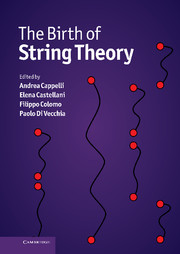Book contents
- Frontmatter
- Contents
- List of contributors
- Photographs of contributors
- Preface
- Abbreviations and acronyms
- Part I Overview
- EARLY STRING THEORY
- Part II The prehistory: the analytic S-matrix
- Part III The Dual Resonance Model
- Part IV The string
- 19 Introduction to Part IV
- 20 From dual models to relativistic strings
- 21 The first string theory: personal recollections
- 22 The string picture of the Veneziano model
- 23 From the S-matrix to string theory
- 24 The analogue model for string amplitudes
- 25 Factorization in dual models and functional integration in string theory
- 26 The hadronic origins of string theory
- TOWARDS MODERN STRING THEORY
- Part V Beyond the bosonic string
- Part VI The superstring
- Part VII Preparing the string renaissance
- Appendix A Theoretical tools of the Sixties
- Appendix B The Veneziano amplitude
- Appendix C From the string action to the Dual Resonance Model
- Appendix D World-sheet and target-space supersymmetry
- Appendix E The field theory limit
- Index
19 - Introduction to Part IV
from Part IV - The string
Published online by Cambridge University Press: 05 May 2012
- Frontmatter
- Contents
- List of contributors
- Photographs of contributors
- Preface
- Abbreviations and acronyms
- Part I Overview
- EARLY STRING THEORY
- Part II The prehistory: the analytic S-matrix
- Part III The Dual Resonance Model
- Part IV The string
- 19 Introduction to Part IV
- 20 From dual models to relativistic strings
- 21 The first string theory: personal recollections
- 22 The string picture of the Veneziano model
- 23 From the S-matrix to string theory
- 24 The analogue model for string amplitudes
- 25 Factorization in dual models and functional integration in string theory
- 26 The hadronic origins of string theory
- TOWARDS MODERN STRING THEORY
- Part V Beyond the bosonic string
- Part VI The superstring
- Part VII Preparing the string renaissance
- Appendix A Theoretical tools of the Sixties
- Appendix B The Veneziano amplitude
- Appendix C From the string action to the Dual Resonance Model
- Appendix D World-sheet and target-space supersymmetry
- Appendix E The field theory limit
- Index
Summary
Introduction
The connection between the Dual Resonance Model (DRM) and the relativistic string, a one-dimensional extended system, was observed soon after Veneziano's fundamental paper. Indeed, the presence of an infinite set of harmonic oscillators, with frequencies that were multiples of a fundamental tune, was clearly suggestive of a vibrating string.
Part IV contains the contributions by the authors who proposed the string interpretation, found the action and studied the quantization. In the years 1969 and 1970, Nambu, Nielsen and Susskind, each from his own perspective, suggested independently that a string model was at the basis of the DRM. In 1970, Nambu, and later Goto, wrote the correct relativistic and reparameterization-invariant form of the string Lagrangian. The different perspectives can be summarized as follows.
(i) Susskind's starting point was the comparison of DRM scattering amplitudes with those for the relativistic harmonic oscillator. From the existence of many frequencies of oscillation, i.e. harmonics, Susskind had the idea of a ‘rubber band’ or a ‘violin string’.
(ii) Nielsen's intuition came from an analogy of dual diagrams with high-order Feynman diagrams, called ‘fishnet diagrams’ in this approximation particles interact approximately with nearest neighbours and effectively form a one-dimensional chain, i.e. a string.
[…]
- Type
- Chapter
- Information
- The Birth of String Theory , pp. 221 - 235Publisher: Cambridge University PressPrint publication year: 2012



